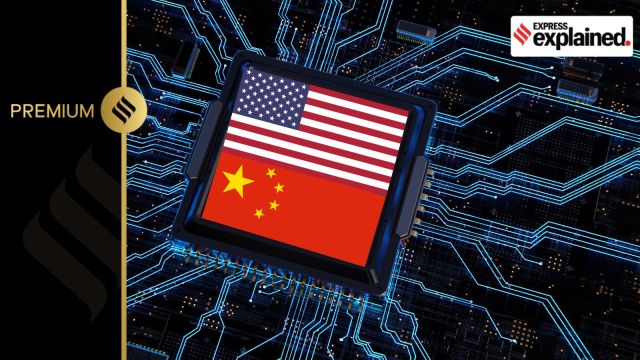Arati Prabhakar, director of the White House Office of Science and Technology Policy, told the Financial Times that despite their trade tensions, especially in sensitive technology sectors, the two countries would work together to “lessen [the] risks and assess [the] capabilities” of AI.

“Steps have been taken to engage in that process,” Prabhakar said on the question of collaboration with China on AI. “We have to try to work [with Beijing].”
Two important events took place between the executive order, issued in August 2023, prohibiting tech transfers to China, and the statement by the White House’s top science adviser.
At the beginning of November, China joined 27 other countries (including India) and the European Union to sign the Bletchley Declaration on evolving standards for AI at the world’s first AI Safety Summit in the United Kingdom.
Later that same month, President Biden met with his Chinese counterpart Xi Jinping on the sidelines of the APEC summit outside San Francisco for wide-ranging discussions including on US export controls for sensitive equipment.
Why is the statement by the White House important?
The change in approach from Washington comes at a time when rapid progress in AI has triggered global concern that this frontier technology could widen vulnerabilities to cyber attacks and spread misinformation, especially as a record 40-odd countries vote in elections this year.
Story continues below this ad
It also coincides with a recent report in Forbes that quoted analysts including Kaifu Lee — a tracker of AI development in China — to claim that the two countries “have reached parity in the development of artificial intelligence but China’s implementation of the technology in products and services is likely to edge ahead of the US this year”.
Chinese AI major Baidu, working in partnership with Internet giants Alibaba and Tencent, has recently unveiled ERNIE, a 23-billion-parameter AI model trained on almost 150 million Chinese image-text pairs. Another Chinese AI model is Taiyi, a bilingual (Chinese-English) large language model trained on some 20 million filtered Chinese image-text pairs and one billion parameters.
China has declared its intent to become the global leader in AI by 2030, and TikTok is seen as a global leader in behavioural algorithms.
Facial recognition is yet another area where China is seen as getting far ahead of the US and Europe, given the heavy deployment of a billion surveillance cameras in Chinese urban centres that are being hooked up with backend AI tools.
Story continues below this ad
How will a collaborative approach towards China work for the US?
While the contours of the new collaboration are unclear, Prabhakar told the FT that while the US may disagree with China on certain values and approaches to regulation, “there will also be places where we can agree”, including on global technical and safety standards for AI software.
Prabhakar underlined, however, that the US “did not intend to slow down AI development, but to maintain oversight of the technology”.
This comes in the backdrop of criticism that the Biden administration had potentially dented the competitive advantage of American tech companies in AI by moving too early to regulate it.
Prabhakar argued that even American AI companies “accepted the need for clear methods to understand and assess AI”. She said the best options available to evaluate the safety of new AI systems were “not up to scratch” because of “the complex and opaque nature of the technology”.
Story continues below this ad
While the US has imposed export curbs on cutting-edge chips such as Nvidia’s latest GPUs to curb China’s ability to train foundational models needed for AI, there is also a realisation in Washington that political divergences notwithstanding, the US and Chinese AI research ecosystems are deeply intertwined. Some of the best AI scientists coming out of China come to the US, and Washington can benefit from some of these ties to China, including the talent flows from that country.
What could be the impact of this seeming reconciliation in other geographies?
A US-China alignment on AI technology, especially its regulation, could have an impact across other geographies, including India.
India has been trying to pitch itself as a country that has effectively used technology to develop and deliver governance solutions on a mass scale — the biometric identity programme Aadhaar and the payments solution Unified Payments Interface (UPI) being examples.
Story continues below this ad
These solutions form the bedrock of what New Delhi calls Digital Public Infrastructure (DPI) — in which the underlying technology is sanctioned by the government, and then offered to private entities to develop various use cases. India wants to take the same DPI approach with AI.
With sovereign AI and an AI compute infrastructure (the software and hardware needed to build AI-powered systems), New Delhi is not looking to merely compete with the generative AI type of model. It also wants to focus on real-life use cases in healthcare, agriculture, governance, language translation, etc., to maximise economic development.
As of now, the European approach to technology rules is seen as being based inherently on regulation for the rights of citizens, while the US approach is more innovator-focussed. According to policymakers, India’s approach so far has been a hybrid of the European and American approaches. The new US-China consensus on tech development and regulation could offer another useful template.








































